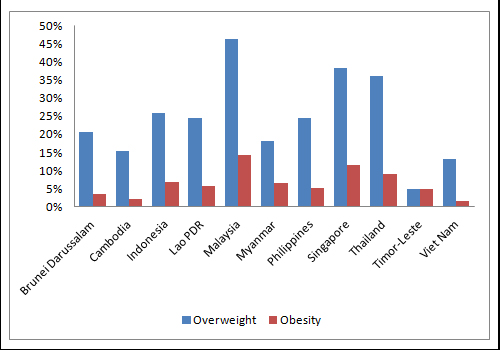Indonesia’s Unhealthiness is Biased Toward the Poor

Please note that we are not authorised to provide any investment advice. The content on this page is for information purposes only.
New ADBI research (Aizawa and Helble, forthcoming) studies how overweight and obesity have become major threats to public health in Indonesia. The evidence shows that obesity, which was previously a problem among high-income groups in the country, has spread across all income groups. Obesity in the lower-income groups, in particular, has been rising rapidly.
New ADBI research (Aizawa and Helble, forthcoming) studies how overweight and obesity have become major threats to public health in Indonesia. The evidence shows that obesity, which was previously a problem among high-income groups in the country, has spread across all income groups. Obesity in the lower-income groups, in particular, has been rising rapidly.
Overweight and obesity significantly increase the risk of suffering from a large number of chronic conditions. Lower income groups are particularly ill-prepared to face continuously high health expenditures, as health systems remain weak. Urgent policy action is needed to mitigate the risk of these groups of falling into poverty due to high health expenditures caused by diseases related to obesity.
In recent years, countries in Asia have led worldwide rankings in terms of their economic growth rates. However, a lesser-known fact is that Asian countries have also ranked highly for increases in the prevalence of overweight and obesity. In Southeast Asia, the prevalence of overweight ranged from 4.9% in Timor-Leste to 46.3% in Malaysia and for obesity from 1.6% in Viet Nam to 14.2% in Malaysia (Figure 1). An estimated 300,000 people die of overweight or obesity every year in the region (WHO 2011).
Figure 1: Prevalence of overweight and obesity in Southeast Asia, 2013
Source: Institute for Health Metrics and Evaluation (2013).
Overweight and obesity are important risk factors for various chronic diseases, such as diabetes, cardiovascular diseases, and musculoskeletal disorders. They are also regarded as important risk factors for endometrial, breast, and colon cancers. Moreover, overweight people face a higher risk of gout, sleep apnea, and obstetric and surgical complications (Jung 1997).
As non-communicable diseases often require lifelong treatment, the increase in overweight and obesity is a strong driver of the surge in medical costs in many countries. The growing number of cases of overweight and obesity is one of the more pressing public health issues, particularly in developing Asia.
As an economy develops, people typically shift from the agricultural sector to the manufacturing and eventually services industries. As a result, their work becomes more sedentary and involves less physical activity.
Hand in hand with economic development comes more income that can be spent on food, as well as better availability of food. It has also been observed that with development, people shift toward the intake of energy-dense foods that are high in fat (Popkin and Du 2003).
The growth in prevalence of overweight and obesity has been widely observed throughout the world. As economies grow, the people affected by both conditions generally changes. In developing countries, higher-income groups are the first to suffer from overweight and obesity. As an economy becomes richer, it is has been observed that lower-income groups also start to gain excessive weight.
Finally, once the economies achieve high-income levels, the wealthy people are less likely to be exposed to the risk of obesity than those with a disadvantaged socioeconomic status (Sobal and Stunkard 1989; McLaren 2007). Systematic evidence for this transition is still lacking for Southeast Asia.
ADBI’s latest research (Aizawa and Helble, forthcoming) closes this gap by providing new evidence on the transition of the socioeconomic related disparity of excessive weight in Indonesia since 1993.
The study shows that the proportions of overweight and obese people in Indonesia have increased rapidly over time, with poorer income groups exhibiting the strongest growth of excessive weight. Although the rates of overweight and obesity are higher among the wealthy, the growth in the rates of the less-advantaged group by far outnumbers that of the rich. The study gives the strong message that overweight and obesity are no longer problems only for the rich people, but increasingly for the poor in Indonesia.
Together with economic growth, lower income groups have increased their body weight, and at a higher pace than higher income groups in Indonesia. Overweight is no longer affecting only the wealthier segments of the population, but the entire socioeconomic spectrum.
The study argues that low-income groups, which are typically less well prepared for the incidence of non-communicable diseases, are now running a higher risk of developing them than before. Policy makers in Indonesia need to think about policies to effectively slow down the increasing speed of the prevalence of obesity, especially among poorer households.
Different from most diseases, overweight and obesity are preventable by changing diets and lifestyle habits. However, inducing such changes is not an easy undertaking. The prevention of overweight and obesity requires a holistic policy approach that includes improved education, cooperation with the food industry, and possibly the introduction of tax incentives.
Taxes on unhealthy foods, such as soft drinks, need to be well designed in order to make sure they achieve their policy objectives while maintaining enough healthy and affordable food choices. Given sharp increases in overweight and obesity in Southeast Asia, more research is needed to better understand the problem and to be able to design appropriate responses that can fully take into account the strong socioeconomic disparities.
Rapid growth of overweight and obesity in Indonesia: Increasing risk for the poor is republished with permission from Asia Pathways





